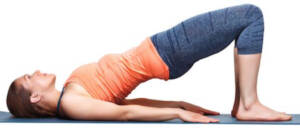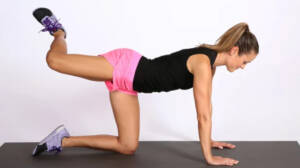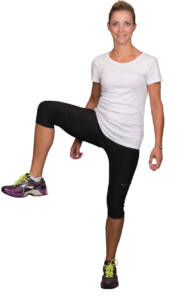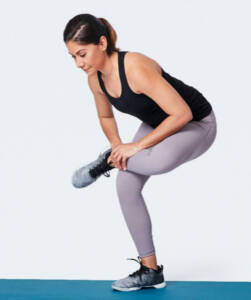Here’s the problem with the pre-run warm up: most of us don’t have the time to do it. So, we skip it and eventually we get injured. Here’s the thing with the pre-run warm up: it doesn’t have to take long. In this article, I show you how to warm up for a run in 5 minutes or less!
First off, it’s important to note that the running warm up we did as kids is OUT and a new way to warm-up is IN.
What’s out: static stretching in which you hold long poses for 15 seconds or so at a time.
What’s in: dynamic stretches where you move through the stretches readying the body for movement.
In addition to the fact that dynamic stretching helps you prevent injury and run faster, it also takes less time to do. So mother runners have little excuse not to do them before their runs (even if they are at 4:30 am!).
Before I get to your 5 minute warm up, I want to offer some basic information on pre-run exercises.
Do you need to warm-up before a run?
Yes, you should warm up before a run—any run—long, short, fast, or slow.
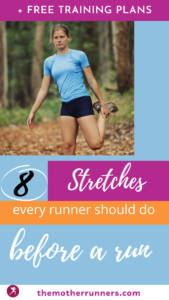
Doing a proper warm up before your run preps the body for activity. It gets your heart pumping blood to your muscles which gets them ready for movement. This limits your risk of injury, enhances running performance, and decreases your muscle soreness after your run.
Think of it this way: a little warm-up is like a cup of coffee for your body. It gets it alert and ready for the day. Not warming up is like when your kid wakes you up and you’re thrown into the day without warning. Not good.
Give your precious body a warning.
How do runners warm up?
Most runners will warm up with some light activity such as air squats to get their blood circulating. Then they will do some dynamic stretches and possibly activation drills like a glute bridge or bird dog. These warm-up exercises will focus primarily on the major leg muscle groups, hips, and core.
Many runners have their own customized warm up running routines depending on injury history. Some runners like to use a foam roller or massage gun to prime muscles for activity.
How should I warm up for a morning run?
You should warm up before a morning run by doing some dynamic leg stretches in your house and then running easy for a mile or two before picking up the pace (if prescribed).
Here is how my morning running routine generally looks if I’m doing a base-building run:
- 5 a.m. wake-up, drink coffee and work on my computer. I eat a bagel with some nut butter.
- 5:50 a.m. I get dressed in the running clothes I laid out the night before.
- 5:55 a.m. I do some dynamic stretches and activation exercises. I also use my Theragun on previously injured areas (my hamstring and my plantar fascia) to ensure adequate blood flow before activity.
- 6:00 a.m. Out the door to run. I run easy for about three miles before doing any faster running.
Related: 9 Steps to Return to Running After Injury
Should I stretch before I run?

You should NOT do a static stretch before a run but you should do dynamic stretching before a run.
Static stretches are when you hold the poses, increasing flexibility. Dynamic stretches are when you move your body through a range of motion such as swinging your leg front and back. Its goal is to increase mobility.
Research shows that static stretching before a run may increase injury risk and decrease running performance. Also, there is no evidence that it decreases muscle soreness.
Conversely, dynamic stretching has been shown to increase VO2 max in runners and prevent injury.
What are dynamic stretches?
Think of dynamic stretches as moving stretches. Instead of holding a pose, you’re moving through a movement pattern that mimics running. Dynamic stretching improves mobility by moving through the range of motion.
Why are dynamic stretches better for runners than static stretches?
The main reason why dynamic stretches are better for runners than static stretches is that they increase mobility over flexibility. Runners do not want to be flexible.
We want our muscles like tight little springs, ready to pop, releasing energy that propels us forward. If you stretch the spring, you have less force to return into the ground.
What’s the difference between flexibility and mobility?
Flexibility is your muscle’s ability to lengthen itself. Mobility is your joint’s ability to move through its full range of motion.
Are mobility exercises and dynamic stretches the same thing?
Essentially, yes. Dynamic stretches enhance mobility whereas mobility drills do the same thing. Mobility drills may involve some muscle activation too such as with a deep lunge and twist.
Should I foam roll as part of my pre-run warm-up?

Using a foam roller as part of your pre-run routine is a great idea if you have the time, but it is not a must. Use it for about 30 seconds on your major leg muscle groups or on an area that needs extra attention.
Related: Benefits of Foam Rolling (& How to Do It)
Using a foam roller before you run can help relax the muscle and promote circulation in the area to ready it for working.
Should I use a massage gun before a run?
Yes, you can use a massage gun as part of your pre-run warm-up routine. Just like you could use a foam roller on a vulnerable area or your major leg muscle groups, use a massage gun for about 30 seconds to promote blood flow and activate the muscle.
Related: Full Bob and Brad Massage Gun Reviews
After your run, use a foam roller and/or massage gun for a couple of minutes on your major leg muscle groups and feet to promote recovery.
Related: Do Massage Guns Help Runners?
5 Minute Warm up Exercises to Do Pre-run
Mother runners, gone are the younger days when didn’t need to do warm up exercises. Ironically, now that we have less time, we need to do a warm-up even more. But these 8 pre-run stretches take little time but make a big difference.
8 Pre-Run Stretches
Air squats
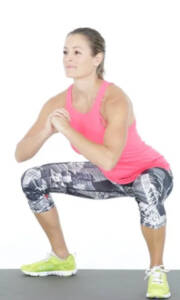
- Stand with your feet shoulder-width apart, toes pointed forward.
- Sit your hips back as if you are sitting in a chair. Keep your chest up and your knees over (not past) your toes. Keep your weight in your heels.
- Tense your glutes and pop back up.
- Repeat 10 times or until you feel your heart rate rise.
Glute bridge
- Lay on the ground to perform a glute bridge which activates the posterior chain.
- Lay on your back with your knees bent.
- Squeeze your glutes and lift your hips up to knee level.

Glute bridge - Return slowly to the floor.
- Repeat 10 times.
Donkey kicks
- Get on all fours with your hands under your shoulders and your hips over your knees. Keep

donkey kick your back flat and tuck your chin.
- Keeping your core straight, lift your leg up and in line with your hips.
- Swing it in a controlled motion forward so that it is in line with your hips.
- Do not rotate your spine when doing this. Repeat 10 times, then do on the other side.
Leg Swings Forward & Backward
Now that you are warmed up and activated, let’s get you mobilized.
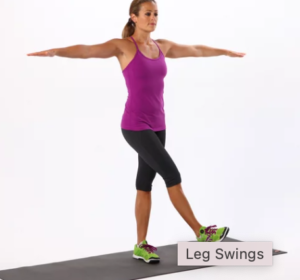
- Find a wall and hold onto it with one hand.
- With a straight leg, swing your leg in front of you and behind you.
- Do 5. Repeat on the other side.
- Then, repeat on both sides with a slightly bent leg.
Leg Swings Side-to-Side
- Next, turn so that you are facing the wall, holding it with both hands.
- Swing your straight leg in front of your body from side to side. Do 5 swings.
- Repeat on the other leg.
- Keep your core straight for all these swings and move in a controlled, not forced, motion.

Standing hurdler dynamic stretch
Standing hurdler stretch
- Still holding the wall in front of you, lift your leg as if you were going over a hurdle. Try to keep your knee bent at 90 degrees and in line with your hip.
- Circle your knee forward five times and backward five times.
- Repeat on the other leg.
- You can also do this stretch on all fours in the fire hydrant position.
Quad pull

- Still holding the wall, gently bend your leg behind you and grab your foot. Give it a gentle pull for just a second or two.
- Repeat ten times and switch to the other side.
- You can also do this dynamic stretch while walking.
Piriformis and IT Band Activation
- Still by the wall or walking, now bring your foot forward in front of you with your knee bend at a 90-degree angle with your foot over the opposite knee.
- Grab it with both hands and gently pull it, feeling a stretch in the glute and lateral quad.

Piriformis and IT Band Activation - Repeat 10 times and switch sides.
Now, you’re ready to go do your easy warm-up job. If you are headed to do speedwork, I also recommend doing running drills. Check out my 8 running drills for speed.
And, if you’re wanting to take your running to the next level or need more running guidance, please check out my run coaching services.

